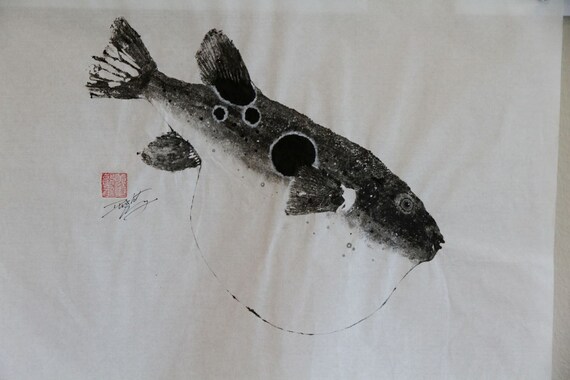
I was surprised because I had the impression that fugu was going to be mind blowingly delicious because people are risking their lives just to enjoy this delicacy. When cooked, fugu flesh turns white and tastes similar to frog legs both in terms of flavor and texture. The flesh is firm with a mild and subtly sweet taste, almost flavorless actually if not for the soy sauce and other condiments. The slices are so thin that they are almost translucent yet does not break easily. Since fugu flesh is quite chewy, it has to be thinly sliced when made into sashimi. We opted for the Guen Course which comes with parboiled torafugu skin, torafugu sashimi, hot-pot, Japanese rice porridge and dessert. The most affordable option starts from 3980 yen and includes 5 dishes – just nice for 2 pax. The recommended way to enjoy fugu here is by having it as the main course Washoku style complete with rice, appetizer, soup and side dishes.Ī couple of course menu are available which you can pick according to your party size and budget. Like the name says, Guenpin Fugu uses only wild torafugu in their restaurant whether it’s hotpot, sashimi, sushi, BBQ or deep fried. It’s an arcade housing probably hundreds of restaurants where you can also find Guenpin Fugu, a restaurant chain that has more than 90 shops in the country specializing in fugu cuisine. If you are visiting Osaka and want to try fugu, E Street is a good place to start. That means there are a lot of fugu specialty restaurants to be found here. Because of that, chefs have to go through years of training before being lawfully allowed to prepare fugu for consumption.Īlthough fugu is available across Japan, over 60% of fugu fished in Japan is consumed in Osaka alone according to reports. However, the wrong concentration of salt, such as a high concentration, could affect the color of the fish, and could even result in death.Guenpin Fugu Osaka Tiger Puffer Fish Course MealĪmong the 22 species of fugu (puffer fish) that you can eat in Japan, the ‘torafugu’ or tiger blowfish is recognized as the highest grade and most poisonous. The effectiveness of salt baths is significant, especially when treating fin/tail rot, or narcolepsy. Most commonly, a 0.3 to 0.7% salt bath is used for between 48 to 120 hours. Through osmosis, the salt water allows the koi to readjust and recover. When koi (carp) have topical damage or a bacterial infection, a salt water bath is recommended. These farms can help to revitalize the economy of nearby cities or towns. Without strict control of the salt content in the natural hot spring water, Onsen Tora-fugu could turn a dark color, and eventually it can lead to death.Īquaculture farming allows areas with no access to the ocean to raise not only pufferfish, but other saltwater creatures (like shrimp). Right before shipment, they are transferred to an artificial seawater tank with salt concentration at 3.4 to 3.5% salt. Onsen Tora-fugu are raised in salt water at no less than 0.4% salt concentration.

Tiger fugu full#
The hot spring raised pufferfish are market-ready in one year, a full six months faster than when a sea cage system is used.

Recent media coverage in Japan has increased public awareness of “Onsen Tora-fugu” (Tiger Pufferfish) that are raised in natural hot spring water. 【Onsen Tora-fugu (Closed Recirculation Aquaculture System)】 Above ground fish farming with closed loop water circulation is called a “closed recirculation aquaculture system.” The irrigation ditch system utilizes above ground irrigation systems to raise the fish. The sea cage system uses cages submerged directly into the ocean, lakes, or ponds. Aquafarming Onsen Tora-fugu (Tiger pufferfish) & Koi (Carp) Fish farming is categorized into two systems: irrigation ditch and sea cage.


 0 kommentar(er)
0 kommentar(er)
